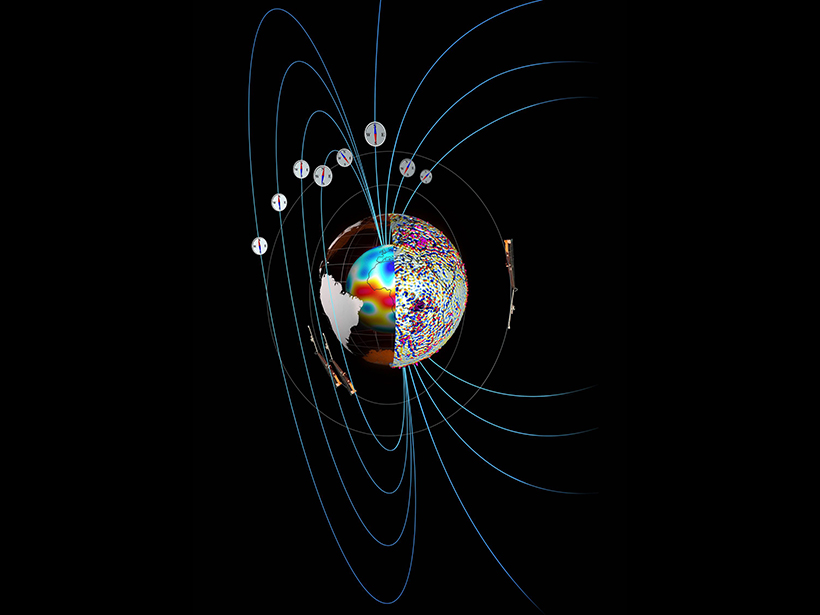The processing algorithms and procedures are constantly being improved, taking advantage of experience gained as the mission progresses.
In November 2013, the European Space Agency (ESA) launched the three-satellite Swarm constellation. This group of satellites provides high-quality measurements of Earth’s magnetic field and associated plasma environment.
Each of the satellites carries a magnetometry package consisting of vector fluxgate and absolute scalar magnetometers, a triple-head star imager, and the electric field instrument, which also includes a Langmuir probe for measuring plasma density and temperature. After 5 years in space, the Swarm mission has achieved remarkable scientific results and has opened the door for many innovative applications beyond its original scope.
To enable full exploitation of the Swarm data, the processing algorithms and procedures are constantly being improved, taking advantage of experience gained as the mission progresses.
Last October, ESA organized the 8th Swarm Data Quality Workshop (SDQW#8). This workshop was instrumental in addressing the processing and use of Swarm data and defining a road map for the following:
- identifying and selecting new Swarm data products and services
- enhancing synergy with other satellite missions
- prioritizing future Swarm-related research activities
- collecting input for the optimization of the orbital constellation in view of addressing a wide spectrum of applications
At the beginning of the workshop, ESA representatives presented the Swarm mission status and programmatic context. The satellites and their payload are in excellent shape after 5 years in space and are ready for a continuation of several more years. Technical sessions covered Swarm data quality status and algorithm improvements from the upgraded data processors operating since September 2018.
Several presentations concerned higher-level processing techniques and modeling strategies for better characterization of the space-time structure of Earth’s core field, core surface flow, and mantle electrical conductivity.
SDQW#8 gave the user community a unique opportunity to interact with the ESA Swarm teams on future scientific challenges, mission planning, and data product refinements.
Development of innovative products describing current systems in the ionosphere and magnetosphere highlighted the growing interest of researchers in the interaction between the ionosphere-thermosphere system and the lower atmosphere and the magnetosphere. The obtained results further encourage investments in refined Swarm products that together with models, have a high potential to quantify a wide variety of processes in our space environment.
The SDQW#8 attendees emphasized the importance of consistent and calibrated multimission data sets with observations of magnetic field and plasma parameters for improved investigations of the interactions between Earth’s magnetic field and external forcing by the Sun. At the workshop, opportunities for synergetic exploitation of Swarm with complementary observations were thoughtfully discussed.
For example, expert groups from Swarm and the China Seismo-Electromagnetic Satellite (CSES, launched in February 2018) will engage in cross-calibration and validation activities. Contributions from the Canadian satellite Enhanced Polar Outflow Probe (e-POP, also known as Swarm Echo) have shown significant progress related to data quality. In addition, data obtained by “platform magnetometers” on satellites like CryoSat, the Gravity Field and Steady-State Ocean Circulation Explorer (GOCE), and the Gravity Recovery and Climate Experiment (GRACE) are promising for geomagnetic field investigations, thermospheric modeling, and space weather applications, even though these missions were initially launched for other purposes.
With 150 attendees, 110 presentations in 11 thematic sessions, and dedicated time slots for discussion, SDQW#8 gave the user community a unique opportunity to interact with the ESA Swarm teams on future scientific challenges, mission planning, and data product refinements.
Information on the workshop and user recommendation are fully described here.
We thank all SDQW#8 participants, in particular the session chairs, for their valuable contribution to a successful workshop.
—Jérôme Bouffard ([email protected]) and Rune Floberghagen, European Space Research Institute, European Space Agency, Frascati, Italy; Nils Olsen, DTU Space, National Space Institute, Technical University of Denmark, Centrifugevej
Citation:
Bouffard, J.,Floberghagen, R., and Olsen, N. (2019), The Swarm satellite trio studies Earth and its environment, Eos, 100, https://doi.org/10.1029/2019EO123269. Published on 10 May 2019.
Text © 2019. The authors. CC BY-NC-ND 3.0
Except where otherwise noted, images are subject to copyright. Any reuse without express permission from the copyright owner is prohibited.

